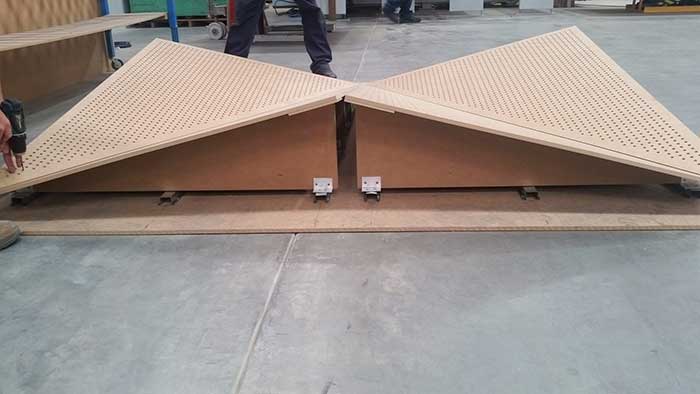Our 3D Panel Capabilities
In the days of increasing dependence on electronic media, and the resulting weariness in seeing flat screens and images, people are appreciating more than ever, the views of what is around them that are three-dimensional and obviously real, as opposed to virtual.
This appreciation of what is real may include going to a shopping centre and seeing items to purchase in real life instead of online shopping, to meeting people face-to-face instead of through social media, to going for a walk in a park and seeing trees, flowers and grass.
It also includes observing the architecture of buildings around us, including of course, since the COVID pandemic, greater discernment of the home space and what I want it to look like and what I want to get from it.
The Biophilic trend has likewise encouraged the use of more natural or organic forms, as opposed to rectangular and square shapes.
Architects have realised these trends in interior design and accordingly, are developing more and more designs with substantial depth to them. This shows itself mostly in respect of ceiling decoration, where a high ceiling or double height space gives plenty of space for expression in this area, but also in furniture design where curves and other unusual shapes are introduced, or deeply textured finishes are used.
SUPAWOOD has developed products to assist architects in forming this three-dimensional landscape, for both interior and exterior surfaces.
You might know some SUPAWOOD products that have substantial depth inherent in their design; for example, WAVE BLADES, WAFFLE BLADES, SUPATILE 3D and SUPACOUSTIC NCK Sawtooth.
What you may not know, however, is that SUPAWOOD will also assist in creating more depth out of our ‘flatter’ products. We do this by supplying or designing framing that juts down from a ceiling or out from a wall, to give an extraordinary feeling of depth or shape to a room or lining.
How SUPAWOOD supplies or designs three-dimensional framing
SUPAWOOD has found it necessary to supply or design three-dimensional framing for contractors and builders, due to these reasons:
- With shrinking construction programs, installers often do not have time to build complicated framing modules on site.
- When the joints between panels are very tight, as in a butt or mitred joint, the tolerance of onsite framing is not sufficient to achieve these joins, and any attempt to do so will lead to disaster.
- Pre-programmed CNC-shaped fins and framing modules are more cost-effective and reliable than framing similar structures on site.
SUPAWOOD has a few different ways of supplying a fixing system that integrates with a 3-D frame, which we will discuss in more detail later.
Once an enquiry for a 3-D fixing and framing system has progressed to a certain point, we will build a prototype and/or supply a detailed drawing in three dimensions, which shows how the support framing will be supplied and built.
In some cases, we will develop the design with the architect, and supply the architect with the necessary 3-D CAD files so that these can be incorporated into the architect’s own drawings.
What types of 3-D framing does SUPAWOOD supply?
Broadly speaking, there are three types of three-dimensional framing that SUPAWOOD supplies. We will list them in order of cost, from most economical to most expensive:
1. Loose framing components for fixing on site to conventional steel framing. In the example shown below, CNC-shaped ribs are supplied to site and are fixed to furring channels at regular intervals. A jig is supplied to ensure even spacing of these ribs as the spacing will affect the overall shape of the ceiling. Panels are then fixed to these ribs, generally using a Supawood concealed fixing system. Supacoustic NCK Sawtooth is an example of this type of framing system.

2. Loose framing components are supplied with notches. These notches allow the shaped framing components to be interlocked and assembled on site into a complete module of a precise shape and tolerance. These modules are then suspended or fixed to a wall. Panels are fixed to the modules on site either before or after fixing to the ceiling or wall.

3. Panels are supplied to site pre-fixed to 3-dimensional framing that is assembled in our factory. This makes for the fastest install time, but increases packaging and transport costs.
SUPATILE 3D is an example of this type of framing system.

Budget pricing for pre-assembled framing or framing components varies from $250 to $1,000 per panel. Note that in addition to costs being affected by the type of framing supplied as described above, costs are also affected by these factors:
- Panel tolerances. The tighter the panel joints, the less construction and install tolerance, which increases costs.
- Number of types of panels. Building multiple panels that are all the same costs a lot less than building multiple panels that are all different to each other.
What special situations can SUPAWOOD help with?
SUPAWOOD can help with virtually any 3-dimensional challenge you might have to face. For example:
- 3D shapes with curves, or twisted panels
- Compound curves
- External Environment

Caption: (L-R) 3D Shapes with Curves or Twisted Panels | Compound Curves | External Environment
We would love to help you with your next project. If you have a challenge right now that you would like us to help you with, please contact us here.
Creating a sense of depth: Part 2

